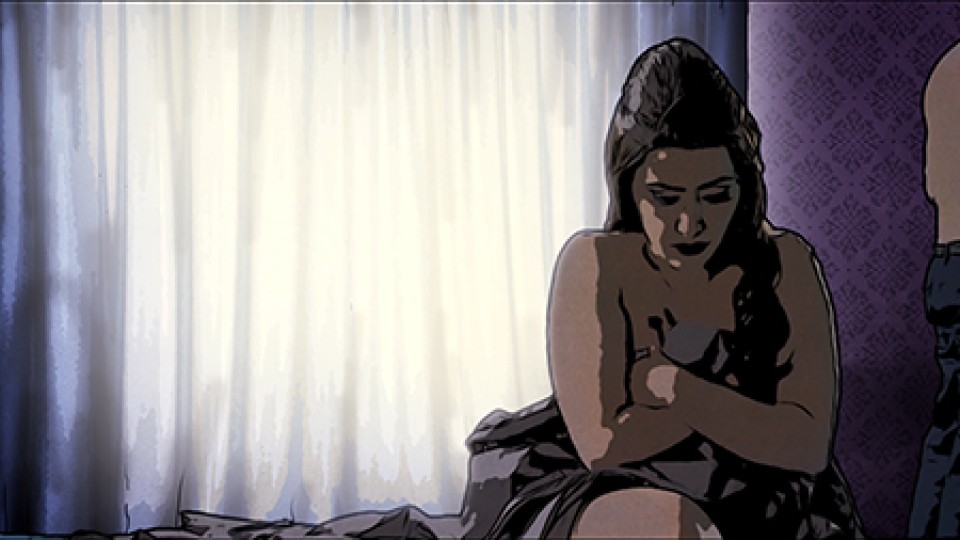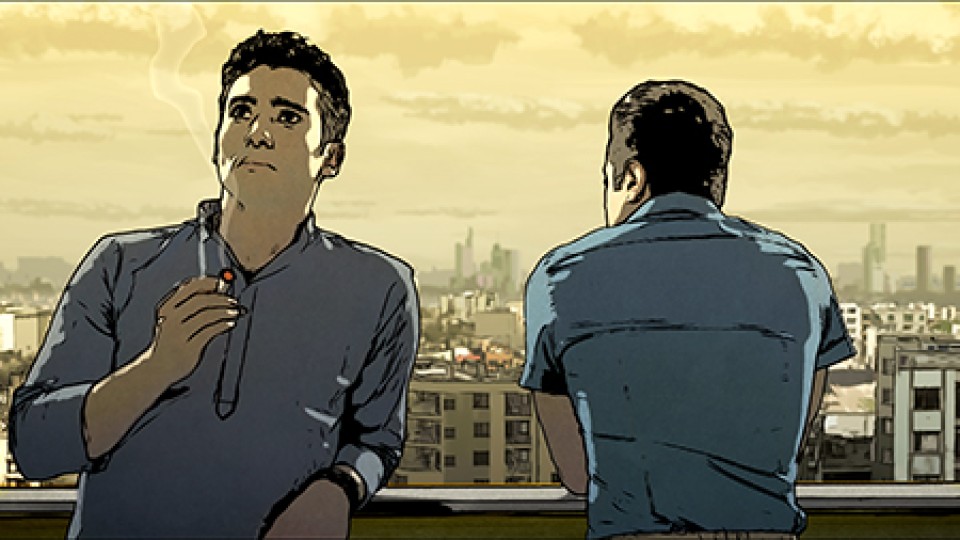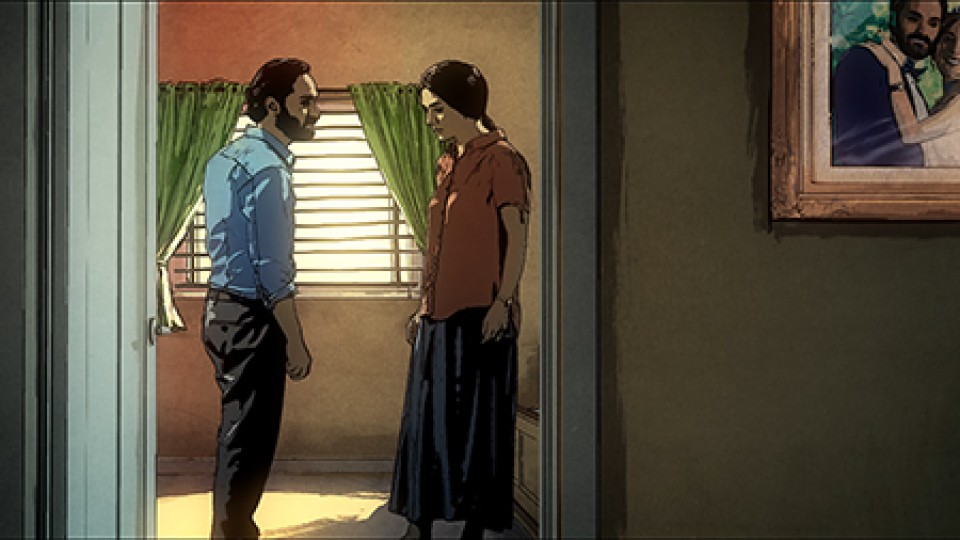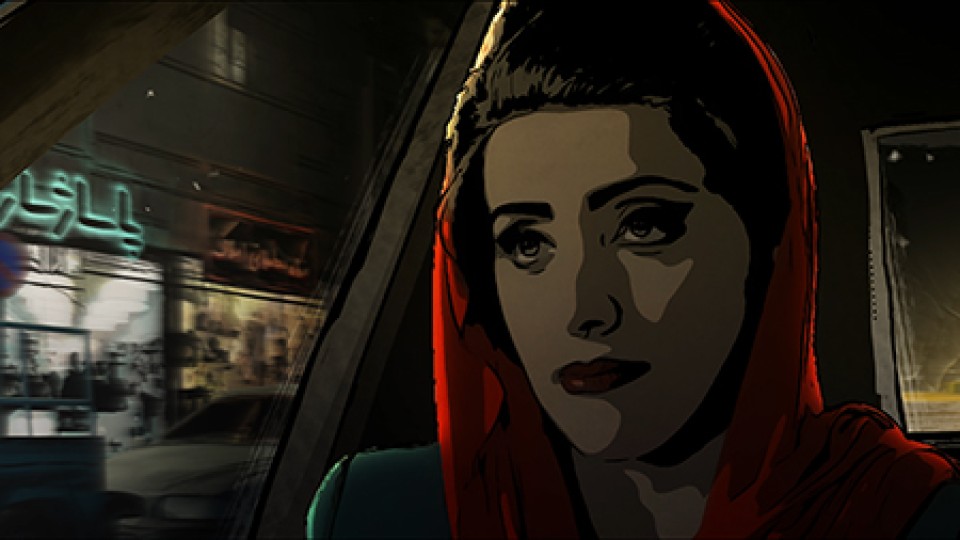In a society where sexual freedom is prohibited by law, the niches of double morality are opened up. In order to narrate a
tale of forbidden Iran in his work Tehran Taboo, director Ali Soozandeh has chosen an animation technique based on images shot live with actors. Cameraman Martin Gschlacht
provides an insight into a completely new approach on set.
The film Tehran Taboo by Ali Soozandeh employs an animation technique which is based on images recorded live. Before we go into detail, could you
give us a brief summary of the fundamentals involved in this technique?
MARITN GSCHLACHT: The idea of making an animation film based on images shot with real actors has been around for a while; one example would
be Waltz With Bashir by Ari Folman from the year 2008. Naturally since then there has been some technical progress, and Little Dream Entertainment
with the director Ali Soozandeh, who have considerable know-how in animation technology, have contributed significantly to
this development. Basically, we made the whole film, shot by shot, with green screen technique. Then, after several separate
steps, the film is put together in the editing room until the entire action – still "against green" – is complete.
At this stage the raw cut has to be extensively discussed, because afterwards you start on the very laborious work of animating
the worlds where the action takes place. So on one hand you have the actors in the green screen studio, and then the digital
world that the characters move in.
Little Dream Entertainment, the coproduction partner, has a lot of know-how in animation. With Tehran Taboo there must also have been contextual reasons which prompted director Ali Soozandeh to choose an animation film in order to
bring his work on the subject of double morality in Tehran society to the big screen?
MARITN GSCHLACHT: Animation readily presented itself as a narrative form for this subject. It would not have been possible to make the film
the way it is with actors in Tehran. And for us at coop 99 as co-producers, this provided the opportunity to make a film which
is extremely contemporary, in terms of subject and visual technique, for a reasonable budget. Little Dream Entertainment has
a great deal of experience with the Pettersson & Findus films, which consist partly of animation and partly of real images. And the director Ali Soozandeh was previously involved
in the making of a documentary film, The Green Wave, based on animation techniques which they have now further developed.
To what extent did the camera work prove to be different in comparison with a "normal shoot"?
MARITN GSCHLACHT: In a green screen situation there are hardly any real reference points. Everything which isn't touched directly by the actors
doesn't exist. The images you capture have to be created in such a way that everything possible can be added in post-production,
including digital tracking shots, pans and zooms. That meant optimal resolution was necessary, though at times only sections
of the image would be used. The decision about whether to use real camera movements or add them later digitally was dependent
on changes in the perspective or lighting. Sometimes we would move round the character with the camera, while other times
we placed the actor on a revolving turntable. One thing we used on almost a daily basis was a conveyor belt, so the actors
could move through the sets virtually. Another reason we had to put in a great deal of thought and planning was that the camera
in the studio has less than 180° freedom of movement. If we filmed in a different direction at the end of the scene, the camera
was kept pointing the same way, but the lighting was changed. That meant a lot of planning to ensure the images would fit
together during editing. I was very glad I could rely on sufficient experience with the technique. When it came to illumination,
the first step was to transform the image to be filmed from black and white into grey tones. The crucial point was understanding
where white, black and grey tones would strike. I have a small program which simulates it in rudimentary fashion, so you could
get a basic idea how a face which was only carved out of light and dark tones would be modelled. It required a completely
different attitude towards working with light. On a monitor the image didn't look like much, but when you thought about it
in the transformed levels of lightness, it was all fine and good. Quite soon, together with the director and the producer,
we agreed not to stick slavishly to the criteria of "right according to the laws of optics" because that would not always
have led to optimum results in the animation. At first we tended to subordinate ourselves to the aim of correctness, but after
a few days we quickly shifted preference to an aesthetic approach, and I paid more attention to ensuring that the face was
perfectly modelled in all its grey tones and less whether it was "correctly" illuminated. In this context darkness is particularly
tricky.
How does this procedure impact on the work of the actors?
MARITN GSCHLACHT: It's similar to real shooting. The gestures the actors make also apply in the animation. Positions and movements are chosen
in the same way as on a classic set. If the scene doesn't come off, it has to be repeated take by take, just as in normal
filming. You can't make the error of thinking that a mistake in acting can be compensated later during the animation. The
actor is processed in the animation, but his work can't be altered. The costumes and make-up for the actors were quite special.
After some preliminary tests we established parameters which made the animation easier and the result better. For example,
clear, powerful colours for costumes and distinctive make-up were helpful for further processing in animation and for the
style of the character, along with strong contour lines on the skin.
To what extent were full sets used?
MARITN GSCHLACHT: There are props and basic elements of the set, if the actor comes into contact with them. For example, if an actor leans against
a table then there's a real table – or just a green plank – depending on the scene. If the actor takes something
in his hand, then that really exists. Sometimes it will be used in the animation the way it is, or it's just a stand-in that
will be replaced later. A car consists of four green seats, a green steering wheel and perhaps a green strip of wood the actor
can rest his arm on. There aren't any real car doors, which was a bit difficult for me and my work in terms of space. If someone
sits in a car in a normal set, I'm confronted with a particular, natural lighting situation that don't exist here. So I have
to create that lighting situation by various means before we can start work: some darkness from above, as if the roof were
there, some light effects to reproduce the light that would be coming through the window, or shadow, and so on. Light effects
for a moving car, or in a disco for example, we would create in real terms and then use in the animation.
One of the challenges facing me was to create lighting in non-existent rooms that made spatial sense, even if we didn't rigidly
stick to that, as I already mentioned. I used plans and sketches to keep an overview. With this production technique it would
be virtually impossible to work without storyboarding. Another basic difference to a conventional film shoot was that you
couldn't film anything that was even slightly out of focus. The animation technique employed in Tehran Taboo requires very sharp edges, so the real image can be processed further. For example, if you film two people with one of them
shot over the shoulder, the shoulder is always slightly out of focus. So you have to film separately – the shoulder by
itself, the person facing you by himself – and then they are put together… and during the animation procedure the
shoulder can be made slightly out of focus, as required. My assistant cameraman Martin Schmachtl worked permanently with depth
of focus tables, and we were constantly working to decide where we had to focus so we would create an image that had all the
elements at least within a very narrow tolerance of focus. As a rule, you use depth of focus as an artistic tool in composing
the image. Here we were dealing with a technical prohibition. It is possible to rectify some filming errors in the post-production
process, but it's a huge additional expense in terms of time and money. I was aware that handling all this was a great responsibility,
and I think we dealt with it pretty well.
What happens when the shooting itself is concluded?
MARITN GSCHLACHT: The first stage is to create a very rough, simplified animation of the actor and then go through the usual editing procedure.
Certain movements are roughly simulated, and in general it requires a great deal of abstraction in order to follow the story
in this stage. When I saw the first raw cut my brain was hardly able to filter out the film and judge the rhythm, because
the raw footage looks so different with this technology. At this point the experience gained by people who had been dealing
with this for years was extremely important, because they were much better able to read this kind of raw cut. On the basis
of the raw cut the animated worlds are created, the backgrounds and the actors combined, and the animation grows step by step.
Then additional camera movements are added: zooms and tracking shots. The film appears piece by piece. It's important to make
an exact decision at the right time during the basic editing, because this detailed work has to take place in a very efficient,
targeted manner. You can slightly shorten the scenes or adapt them rhythmically afterwards, but replacing entire scenes –
or deleting them – would take a huge amount of time at a later stage, and of course it would cost a lot.
What was the attraction for you in this kind of camerawork, even if – as you said before – your original shots may
not actually be visible in the finished film?
MARITN GSCHLACHT: First of all, I was very attracted to the script, the story of Tehran Taboo. The film deals with relevant, difficult subjects in a very impressive way. And quite early on there was a trailer which convinced
me about the animation technique and the visual quality of the project. Another fascinating aspect was that I didn't have
to subordinate myself to reality. Generally, as a cameraman, I'm largely subservient to physics when it comes to lighting,
shadow and movement. I've always envied painters who can combine very high-contrast lighting with wonderful, soft shadows.
That looks just great. But it's not so easy in my profession. When you work with a technique like the one we used on Tehran Taboo it suddenly becomes possible to step outside physical limitations to some extent. You find yourself in a world that revolves
around an exaggerated form of ascetics. And that's really appealing!
In 2008/9 you did the camerawork for Shirin Neshat’s film Women Without Men, and you are finishing her new production at the moment. Now you have been involved with Ali Soozandeh and Ali Samadi Ahadi,
the producer of Tehran Taboo, so you have again worked with artists from an Iranian background. Is it perhaps not just a matter of chance and opportunity;
is there perhaps also a world, a visual language, a communicative level that links you with this culture in particular?
MARITN GSCHLACHT: In terms of the visual language, as a cameraman I attempt to work together with the director and the other creatives in every
film on an aesthetic that corresponds as closely as possible to the film. I don't essentially feel more intensely or less
closely bound to any particular aesthetic approach. No matter whether the project is set in the ice age, in the housing projects
of Vienna or in Tehran. However, one thing you could perhaps describe as a "world" is the nature of exiled Iranians, and by
now I've had the opportunity to meet a lot of them in the USA, France, Germany and Austria. They are incredibly likeable,
appreciative, hard-working and, in a particular way, successful people. I think being torn away from your roots – and
many of them had to leave their country as children, young people or adults, often in very dramatic circumstances – does
something to people, to their lives and their aims in life. It seems to me that I perceive a lust for creative work, and a
wish to be part of a community where that takes place. They work in closely linked groups. I've just been in Paris, where
Shirin Neshat is editing the new film, and after work we would often meet people from these communities. I found the whole
atmosphere very warm, friendly and artistic. In fact, I'm beginning to think it's high time I learnt Farsi.
Interview: Karin Schiefer
May 2017
Translation: Charles Osborne






